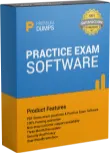
Get PECB ISO-9001-Lead-Auditor Exam Dumps
PECB QMS ISO 9001:2015 Lead Auditor Exam Dumps
This Bundle Pack includes Following 3 Formats
Test software
Practice Test
Answers (PDF)

ISO-9001-Lead-Auditor Desktop Practice
Test Software
Total Questions : 110

ISO-9001-Lead-Auditor Questions & Answers
(PDF)
Total Questions : 110

ISO-9001-Lead-Auditor Web Based Self Assessment Practice Test
Following are some ISO-9001-Lead-Auditor Exam Questions for Review
'XYZ' has already sent to you a list with all documented procedures and work instructions related to the services provided to 'ABC' (a quality manual is not included in the list).
To complete the audit planning which additional information would you ask to XYZ to submit? Select four.
Which two of the following roles do not contribute to the audit outcomes?
Individual(s) managing the audit programme
Which two of the following statements related to Stage 1 of an initial certification audit against ISO 9001:2015 are true?
During the Stage 1 audit, the audit team:
In the context of a third-party certification audit, it is very important to have effective communication. Which is not the responsibility of the audit team leader?
Knowledge and skills are requirements of the auditor's competence. Select two from the following topics of knowledge that apply to every member of an audit team auditing an ISO 9001 quality management system.
Unlock All Features of PECB ISO-9001-Lead-Auditor Dumps Software
Types you want
pass percentage
(Hours: Minutes)
Practice test with
limited questions
Support